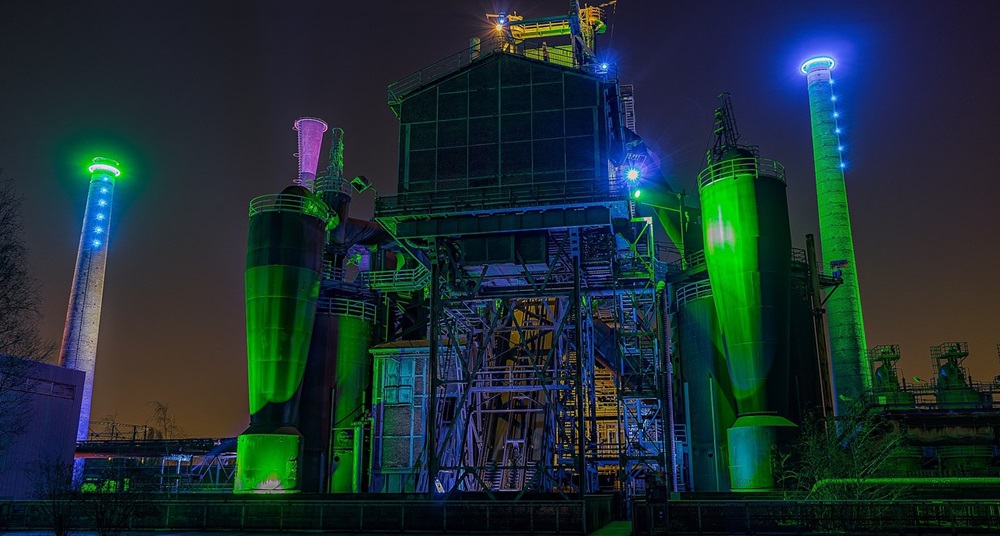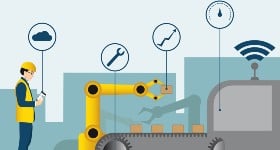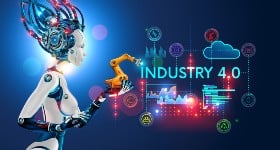
Ever think about the effects IoT is having on the automotive industry? Of course, electric cars, advanced in-vehicle assistants, maybe even self-driving pods are what come to mind. But have you ever considered how new technologies are changing the facilities that are responsible for manufacturing the next era of vehicles?
Automotive plants are some of the fastest adopters of Industry 4.0 technology, a movement that promises long term pay-offs like cheaper day-to-day operating costs and optimization insights that result in operational quality and consistency we could have only imagined a few decades ago.
Why not start in the factory?
According to Current, a technology division of GE focused on intelligent lighting, auto companies are leveraging the energy efficiency and sensor data made available with ubiquitous LED lighting. When customers realize LEDs are uniquely positioned above all the activity on a factory floor, you could say they “see the light” when it comes to understanding what digital transformation can really do.
“For many of our clients, connected factories start with lighting,” said Rudy Calderon, GM of Industrial Accounts at Current. “There has never been a better time to bring LED lighting into factories of all kinds, given the near immediate ROI thanks to reduced operational costs.”
Calderon said, providing less expensive components alongside advanced software has been the key to getting large deployment economics right, but there’s the added advantage of how easy it is to retrofit LEDs. “We landed on exactly the right mix, of smaller, lighter-weight lighting systems including sensors that are also durable and promise long life,” Calderon explained. “There is cost of labor to implementing any system, and in large factories, ceiling lighting is a huge part of their infrastructure, and critical to their operations.”
Lighting the way
GE was the first to discover visible light emitting diodes, or “Visible LEDs.” In 1962 Nick Holonyack, a consulting engineer for GE, invented the first visible light LED, and the company has been taking steps to advance it ever since – like acquiring the energy business Current in 2015. Calderon commented, “We now find ourselves in a very bright spot! LEDs are more flexible than ever and save our clients and partners 50-70% depending on the deployment.”
Calderon says the factory operators are investing cost savings from energy efficient and implementing their more advanced IoT initiatives, like intelligent sensors. They know they are going to save money on the improvements in lighting and while those improvements are being installed, they can begin implementing other connected systems which are making factories safer and more productive.
“It’s really quite simple; while taking off old fixtures and installing new fixtures, why not install a wireless network and system,” Calderon said. “More and more companies are investing in fixtures that include integrated sensors and are combining our LED products with our Daintree wireless system. Data goes into the cloud and clients can run it through partner applications to uncover insights, to make the space far more productive than it has been.”
Current’s Daintree Wireless Control system can produce up to 20% more savings on top of the 50% from LED lighting alone, according to the company. The Daintree Wireless Control System provides the ability to implement basic motion or occupancy sensing, as well as more advanced task-tuning, light-level adjustments and schedule-based control strategies.
“The same network can be leveraged for more efficient use and predictive maintenance of many other expensive assets,” Calderon said. This includes HVAC systems, RTUs, exhaust fans, forklift charging stations, air compressors, and more.
Open-at-the-top, open-at-the-bottom
Calderon also called out the importance of interoperability and Current’s belief in open ecosystems. “Rather than locking clients into proprietary systems, Daintree is an ‘open-at-the-top, open-at-the-bottom’ platform, which means it is compatible with an ecosystem of certified third-party ZigBee devices. The ability to integrate with other control vendors provides more flexibility, choice, speed, and lower project costs than in a proprietary system.”
Beyond lighting and standard controls, more sophisticated intelligent environments are beginning to feature advanced software applications that drive additional business productivity gains.
“Our ‘open-at-the-top’ approach provides clients with an open API that facilitates integration with other solutions. Users are free to construct their own apps or utilize third-party apps.” Current works with a network of over 100 technology partners serving enterprises and cities.
“For example, our partnership with TrackVia streamlines operations and protects high-dollar assets with mobile-enabled work order management,” Calderon said.
“Every minute a line is shut down, or a piece of equipment or a part cannot be found can cost thousands of dollars,” Calderon said. “The cost to add features like asset or part tracking is very small, especially when those connected features are put in place when LED lighting is upgraded.
Using BLE sensors, for example, allows for tagging of assets, using RFID, and improves the “supply chain” dynamics inside intelligent factories.
Beyond factories
Current is supporting several large auto brands in the US and is also taking their lighting technologies to the very streets those autos will be driving on. “We are involved in huge opportunities right now with our City IQTM sensor offering,” Calderon said. “In the smart city arena, we’re seeing investments driven by visionary leaders working to make life easier for citizens in the community – traffic flow, parking spot availability and more. We’re also seeing tremendous innovation in things like public safety, with gunshot detection, support of first responders, and anti-terrorism surveillance.”
“So many tools are being developed, and we expect this to accelerate in 2019,” Calderon said. “City infrastructure should be digital in additional to physical. What we used to call light poles are now valuable vertical assets that save energy but also act as a smart phone that collects environmental data, acoustics and video to enable unlimited possibilities for improving traffic, safety and mobility and much more.”
“We’re successful when architectures enable people to use data and create different types of productivity tools that can drive the growth and create applications we may never have thought of,” Caldernon commented.
With large scale smart city projects across North America, Rudy emphasized that, “platforms need to be open and buyers need to be able to select the best products and technologies to serve their specific needs. Every city has different goals and objectives. Not every building is the same. The more open and collaborative we are, the more IoT can expand the connected world and bring us together.”
GE announced earlier this year that Current, which was started in 2015, will be acquired by American Industrial Partners.
https://www.currentbyge.com/ideas/american-industrial-partners-to-acquire-current-powered-by-ge
We will continue to follow Current’s momentum and announcements heading into the near year. In the meantime, more can be found by reading this Frost & Sullivan white paper. https://www.currentbyge.com/ideas/automotive-digitization-time-to-shift-focus-to-intelligent-environments
Edited by
Ken Briodagh





